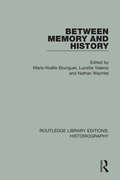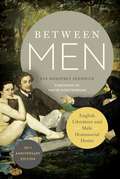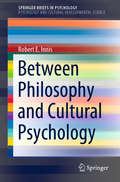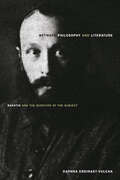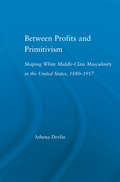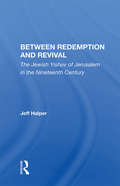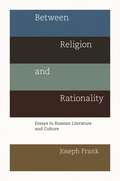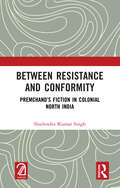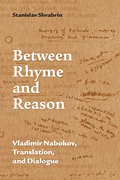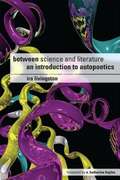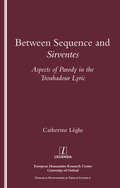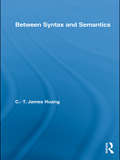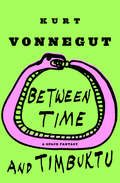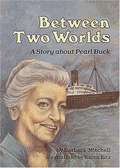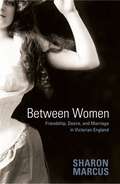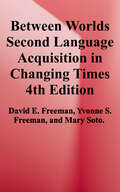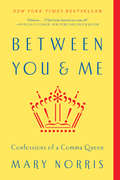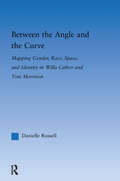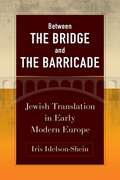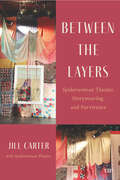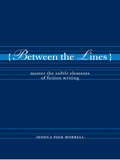- Table View
- List View
Between Memory and History (Routledge Library Editions: Historiography #6)
by Lucette Valensi Marie-Noëlle Bourguet Nathan WachtelThe recent wave of interest in oral history and return to the active subject as a topic in historical practice raises a number of questions about the status and function of scholarly history in our societies. This articles in this volume, originally pubished in 1990, and which originally appeared in History and Anthropology, Volume 2, Part 2, discuss what contributions, meanings and consequences emerge from scholarly history turning to living memory, and what the relationships are between history and memory.
Between Men: English Literature and Male Homosocial Desire (Gender and Culture Series)
by Eve Kosofsky SedgwickFirst published in 1985, Between Men was a decisive intervention in gender studies, a book that all but singlehandedly dislodged a tradition of literary critique that suppressed queer subjects and subjectivities. With stunning foresight and conceptual power, Eve Kosofsky Sedgwick's work opened not only literature but also politics, society, and culture to broader investigations of power, sex, and desire, and to new possibilities of critical agency.Illuminating with uncanny prescience Western society's evolving debates on gender and sexuality, Between Men still has much to teach us. With a new foreword by Wayne Koestenbaum emphasizing the work's ongoing relevance, Between Men engages with Shakespeare's Sonnets, Wycherley's The Country Wife, Sterne's A Sentimental Journey Through France and Italy, Hogg's The Private Memoirs and Confessions of a Justified Sinner, Tennyson's The Princess, Eliot's Adam Bede, Thackeray's The History of Henry Esmond, Esq., and Dickens's Our Mutual Friend and The Mystery of Edwin Drood, among many other texts. Its pathbreaking analysis of homosocial desire in Western literature remains vital to the future of queer studies and to explorations of the social transformations in which it participates.
Between Philosophy and Cultural Psychology (SpringerBriefs in Psychology)
by Robert E. InnisThis Brief provides an in-depth discussion of five major points of intersection between philosophy and cultural psychology. The first chapter frames central analytical and normative threads, foregrounding the focal notion of thresholds of sense. The second chapter explores the nature of contexts, situations, and backgrounds of meaning-making following the lead of John Dewey, Ben-Ami Scharfstein, and Gernot Böhme. Chapter three examines the complementary analytical power of the semiotic resources developed in the work of Peirce, Bühler, and Cassirer. Chapter four shows the heuristic fertility and psychological bearing of Susanne Langer's feeling-based aesthetic model of minding. The final chapter establishes affectivation as the inescapable consequence of human beings giving life to themselves by giving life to signs. The Brief concludes with three commentaries from leading researchers in the area. The chapters weave together interlocking themes: the nature of embodied perception, the variety of contexts and semiotic frameworks and their schematization of thresholds of meaning-making, the role of art and theories of imagination both in cultural psychology and in philosophy, and the centrality of feeling in all forms of meaning-making. Between Philosophy and Cultural Psychology will be of interest to cognitive and cultural psychologists as well as researchers and upper-graduate students in philosophy and related psychology fields.
Between Philosophy and Literature: Bakhtin and the Question of the Subject
by Daphna Erdinast-VulcanThis is an original reading of Mikhail Bakhtin in the context of Western philosophical traditions and counter-traditions. The book portrays Bakhtin as a Modernist thinker torn between an ideological secularity and a profound religious sensibility, invariably concerned with questions of ethics and impelled to turn from philosophy to literature as another way of knowing. Most major studies of Bakhtin highlight the fragmented and apparently discontinuous nature of his work. Erdinast-Vulcan emphasizes, instead, the underlying coherence of the Bakhtinian project, reading its inherent ambivalences as an intersection of philosophical, literary, and psychological insights into the dynamics of embodied subjectivity. Bakhtins turn to literature and poetry, as well as the dissatisfactions that motivated it, align him with three other "exilic" Continental philosophers who were his contemporaries: Bergson, Merleau-Ponty, and Levinas. Adopting Bakhtins own open-ended approach to the human sciences, the book stages a series of philosophical encounters between these thinkers, highlighting their respective itineraries and impasses, and generating a Bakhtinian synergy of ideas.
Between Profits and Primitivism: Shaping White Middle-Class Masculinity in the U.S., 1880-1917 (Literary Criticism and Cultural Theory)
by Athena DevlinBetween 1800 and the First World War, white middle-class men were depicted various forms of literature as weak and nervous. This book explores cultural writings dedicated to the physical and mental health of the male subject, showing that men have mobilized gender constructions repeatedly and self-consciously to position themselves within the culture. Aiming to join those who offer nuanced accounts of masculinity, Devlin investigates the various and changing interests white manhood was positioned to cultivate and the ways elite white men used "their own," so to speak, to promote larger agendas for their class and race.
Between Redemption And Revival: The Jewish Yishuv Of Jerusalem In The Nineteenth Century
by Jeff HalperIn the Zionist view of Israeli history, the Old Yishuv of Jerusalem - the Jewish community of the 19th and early 20th centuries - was "a lifeless body ruled by hypocrites, cheats and unschooled rabbis", and its importance was downplayed and ignored in this study of the Old Yishuv, Dr Halper uncovers the personalities, issues, and events that formed
Between Religion and Rationality: Essays in Russian Literature and Culture
by Joseph FrankIn this book, acclaimed Dostoevsky biographer Joseph Frank explores some of the most important aspects of nineteenth and twentieth century Russian culture, literature, and history. Delving into the distinctions of the Russian novel as well as the conflicts between the religious peasant world and the educated Russian elite, Between Religion and Rationality displays the cogent reflections of one of the most distinguished and versatile critics in the field. Frank's essays provide a discriminating look at four of Dostoevsky's most famous novels, discuss the debate between J. M. Coetzee and Mario Vargas Llosa on the issue of Dostoevsky and evil, and confront Dostoevsky's anti-Semitism. The collection also examines such topics as Orlando Figes's sweeping survey of the history of Russian culture, the life of Pushkin, and Oblomov's influence on Samuel Beckett. Investigating the omnipresent religious theme that runs throughout Russian culture, even in the antireligious Chekhov, Frank argues that no other major European literature was as much preoccupied as the Russian with the tensions between religion and rationality. Between Religion and Rationality highlights this unique quality of Russian literature and culture, offering insights for general readers and experts alike.
Between Resistance and Conformity: Premchand’s Fiction in Colonial North India
by Shailendra Kumar SinghThis book examines the questions of conformity and resistance with respect to Premchand’s literary corpus. Mapping the various complexities, challenges, and contradictions of interwar India, it demonstrates how the passive peasant protagonists of the writer’s fictional works present a diametrically opposed definition of dharma as compared to their dissident nationalist counterparts. Through a relatively similar logic of comparative assessment, it further foregrounds the fundamental asymmetry that exists between Premchand’s literary representations of women as compliant domestic subjects and those that portray them as rebel patriots of colonial North India. Juxtaposing several genres, including novels, short stories, letters, and journalistic writings to offer a reconsideration of Premchand's work, this book will interest scholars of peasant narratives, nationalist fiction, and gender studies.Print edition not for sale in South Asia (India, Sri Lanka, Nepal, Bangladesh, Pakistan or Bhutan)
Between Rhyme and Reason: Vladimir Nabokov, Translation, and Dialogue
by Stanislav ShvabrinThe author of such global bestsellers as Lolita and Pale Fire, Vladimir Nabokov (1899–1977) is also the most controversial literary translator and translation theorist of our time. In Between Rhyme and Reason, Stanislav Shvabrin discloses the complexity, nuance, and contradictions behind the writer’s theory and practice of "literalism" to reveal how and why translation came to matter to him so much. Drawing on familiar as well as unknown materials, Shvabrin traces the surprising and largely unknown trajectory of Nabokov’s life-long fascination with translation to demonstrate that, for him, translation was a form of intellectual communion with his peers across no fewer than six languages. Empowered by Mikhail Bakhtin’s insights into the interactive roots of literary creativity, Shvabrin’s interpretative chronicle of Nabokov’s involvement with translation shows how his "dialogic encounters" with others in the medium of translation left "verbal vestiges" on his creations. Refusing to regard translation as a form of individual expression, Nabokov translated to communicate with his interlocutors whose words and images continue to reverberate throughout his allusion-rich texts.
Between Science and Literature: AN INTRODUCTION TO AUTOPOETICS
by Ira LivingstonBetween Literature and Science follows through to its emerging 21st-century future the central insight of 20th-century literary and cultural theory: that language and culture, along with their subsystems and artifacts, are self-referential systems. The book explores the workings of self-reference (and the related performativity) in linguistic utterances and assorted texts, through examples of the more open social-discursive systems of post-structuralism and cultural studies, and into the sciences, where complex systems organized by recursive self-reference are now being embraced as an emergent paradigm. This paradigmatic convergence between the humanities and sciences is autopoetics (adapting biologist Hubert Maturana's term for "self-making" systems), and it signals a long-term epistemological shift across the nature/culture divide so definitive for modernity. If cultural theory has taught us that language, because of its self-referential nature, cannot bear simple witness to the world, the new paradigmatic status of self-referential systems in the natural sciences points toward a revived kinship of language and culture with the world: language bears "witness" to the world. The main movement of the book is through a series of model explications and analyses, operational definitions of concepts and terms, more extended case studies, vignettes and thought experiments designed to give the reader a feel for the concepts and how to use them, while working to expand the autopoetic internee by putting cultural self-reference in dialogue with the self-organizing systems of the sciences. Along the way the reader is introduced to self-reference in epistemology (Foucault), sociology (Luhmann), biology (Maturana/Varela/Kauffman), and physics and cosmology (Smolin). Livingston works through the fundamentals of cultural, literary, and science studies and makes them comprehensible to a non-specialist audience.
Between Sequence and Sirventes: Aspects of the Parody in the Troubadour Lyric
by Catherine Leglu"Parody marks the troubadour lyric from the outset, informing composition, performance and reception. This ground breaking study moves away from courtliness, the focus of most previous studies, and places troubadour parodic preactice int he context of the social and spiritual debates of 12th and 13th century Occitania. Leglu analyses the complex relationship between troubadour verse and the Aquitanian para-liturgical Latin corpus. She charts the development of a chain of texts linked by a common formal mode derived from this Latin sequence and traces patterns of rewriting, ranging from scurrilous attacks, through playful competition, to recuperation of the sacred content in serious parody."
Between Syntax and Semantics (Routledge Leading Linguists)
by C.T. James HuangThis indispensable volume contains articles that represent the best of Huang's work on the syntax-semantics interface over the last two decades. It includes three general topics: (a) questions, indefinites and quantification, (b) anaphora, (c) lexical structure and the syntax of events.
Between Time and Timbuktu: Or, Prometheus-5, a Space Fantasy
by Kurt VonnegutAn experimental television play composed of excerpts from his novels and stories, Between Time and Timbuktu features Kurt Vonnegut&’s special blend of scientific expertise, wit, and penetrating comment. &“Most unusual, ultra imaginative . . . a sort of cross between 2001: A Space Odyssey and Alice in Wonderland.&”—Philadelphia InquirerThe basic story line: Young Stony Stevenson wins a jingle contest and, as his prize, is blasted off into the time-space warp. The country&’s first poet-astronaut thus experiences both past and future human history simultaneously. His observations on it consist mainly of dramatized selections from the author&’s works. The result is a unique Vonnegut sampler cast in the form of &“an excellent drama&” (Pittsburgh Press).
Between Two Worlds: A Story about Pearl Buck
by Barbara MitchellA biography of the woman who was awarded both the Pulitzer and Nobel prizes for literature.
Between Two Worlds: My Life and Captivity in Iran
by Roxana SaberiA chronicle of the Iranian-American journalist's imprisonment, as well as a look at Iran and its political tensions.
Between Women: Friendship, Desire, and Marriage in Victorian England
by Sharon MarcusWomen in Victorian England wore jewelry made from each other's hair and wrote poems celebrating decades of friendship. They pored over magazines that described the dangerous pleasures of corporal punishment. A few had sexual relationships with each other, exchanged rings and vows, willed each other property, and lived together in long-term partnerships described as marriages. But, as Sharon Marcus shows, these women were not seen as gender outlaws. Their desires were fanned by consumer culture, and their friendships and unions were accepted and even encouraged by family, society, and church. Far from being sexless angels defined only by male desires, Victorian women openly enjoyed looking at and even dominating other women. Their friendships helped realize the ideal of companionate love between men and women celebrated by novels, and their unions influenced politicians and social thinkers to reform marriage law. Through a close examination of literature, memoirs, letters, domestic magazines, and political debates, Marcus reveals how relationships between women were a crucial component of femininity. Deeply researched, powerfully argued, and filled with original readings of familiar and surprising sources, Between Women overturns everything we thought we knew about Victorian women and the history of marriage and family life. It offers a new paradigm for theorizing gender and sexuality--not just in the Victorian period, but in our own.
Between Worlds
by William PallisterJohn Milton's Paradise Lost has long been celebrated for its epic subject matter and the poet's rhetorical fireworks. In Between Worlds, William Pallister analyses the rhetorical methods that Milton uses throughout the poem and examines the effects of the three distinct rhetorical registers observed in each of the poem's major settings: Heaven, Hell, and Paradise.Providing insights into Milton's relationship with the history of rhetoric as well as rhetorical conventions and traditions, this rigorous study shows how rhetorical forms are used to highlight and enhance some of the poem's most important themes including free will, contingency and probability. Pallister also provides an authoritative discussion of how the omniscience of God in Paradise Lost affects Milton's verse, and considers how God's speech applies to the concept of the perfect rhetorician.An erudite and detailed study of both Paradise Lost and the history of rhetoric, Between Worlds is essential reading that will help to unravel many of the complexities of Milton's enduring masterpiece.
Between Worlds: Second Language Acquisition in Changing Times
by Yvonne S. Freeman David E. Freeman Mary SotoLong considered a groundbreaking text for pre-service, in-service, mainstream, and EL teachers, the bestselling Between Worlds is now available in an updated Fourth Edition. <p><p>As student populations across the U.S. reflect increasing racial, ethnic, and linguistic diversity in changing times, the need for effective, research-based classroom practices has never been greater. The Fourth Edition includes what you need to effectively provide equitable instruction for emergent bilingual students including: <p>- How to implement activities/strategies for in class, online, and hybrid settings <p>- How to address racial/social justice issues <p>- How to respond to immigrant student concerns in the current political climate <p>- How to incorporate students' home languages through translanguaging. <p><p>Ever mindful of the needs of teachers in a range of settings, Freemans and Soto include new classroom vignettes and case studies of teachers and students to illustrate what best-practice second language acquisition instruction looks like in today's schools.
Between You & Me: Confessions of a Comma Queen
by Mary Norris"Hilarious. . . . This book charmed my socks off." --Patricia O'Conner, New York Times Book Review Mary Norris has spent more than three decades in The New Yorker's copy department, maintaining its celebrated high standards. Now she brings her vast experience, good cheer, and finely sharpened pencils to help the rest of us in a boisterous language book as full of life as it is of practical advice. Between You & Me features Norris's laugh-out-loud descriptions of some of the most common and vexing problems in spelling, punctuation, and usage--comma faults, danglers, "who" vs. "whom," "that" vs. "which," compound words, gender-neutral language--and her clear explanations of how to handle them. Down-to-earth and always open-minded, she draws on examples from Charles Dickens, Emily Dickinson, Henry James, and the Lord's Prayer, as well as from The Honeymooners, The Simpsons, David Foster Wallace, and Gillian Flynn. She takes us to see a copy of Noah Webster's groundbreaking Blue-Back Speller, on a quest to find out who put the hyphen in Moby-Dick, on a pilgrimage to the world's only pencil-sharpener museum, and inside the hallowed halls of The New Yorker and her work with such celebrated writers as Pauline Kael, Philip Roth, and George Saunders. Readers--and writers--will find in Norris neither a scold nor a softie but a wise and witty new friend in love with language and alive to the glories of its use in America, even in the age of autocorrect and spell-check. As Norris writes, "The dictionary is a wonderful thing, but you can't let it push you around."
Between You & Me: Confessions of a Comma Queen
by Mary NorrisThe most irreverent and helpful book on language since the #1 New York Times bestseller Eats, Shoots & Leaves. Mary Norris has spent more than three decades in The New Yorker's copy department, maintaining its celebrated high standards. Now she brings her vast experience, good cheer, and finely sharpened pencils to help the rest of us in a boisterous language book as full of life as it is of practical advice. Between You & Me features Norris's laugh-out-loud descriptions of some of the most common and vexing problems in spelling, punctuation, and usage--comma faults, danglers, "who" vs. "whom," "that" vs. "which," compound words, gender-neutral language--and her clear explanations of how to handle them. Down-to-earth and always open-minded, she draws on examples from Charles Dickens, Emily Dickinson, Henry James, and the Lord's Prayer, as well as from The Honeymooners, The Simpsons, David Foster Wallace, and Gillian Flynn. She takes us to see a copy of Noah Webster's groundbreaking Blue-Back Speller, on a quest to find out who put the hyphen in Moby-Dick, on a pilgrimage to the world's only pencil-sharpener museum, and inside the hallowed halls of The New Yorker and her work with such celebrated writers as Pauline Kael, Philip Roth, and George Saunders. Readers--and writers--will find in Norris neither a scold nor a softie but a wise and witty new friend in love with language and alive to the glories of its use in America, even in the age of autocorrect and spell-check. As Norris writes, "The dictionary is a wonderful thing, but you can't let it push you around."
Between You & Me: Confessions of a Comma Queen
by Mary NorrisMary Norris has spent more than three decades in The New Yorker's copy department, maintaining its celebrated high standards. Now she brings her vast experience, good cheer, and finely sharpened pencils to help the rest of us in a boisterous language book as full of life as it is of practical advice.<P><P> Between You & Me features Norris's laugh-out-loud descriptions of some of the most common and vexing problems in spelling, punctuation, and usage--comma faults, danglers, "who" vs. "whom," "that" vs. "which," compound words, gender-neutral language--and her clear explanations of how to handle them. Down-to-earth and always open-minded, she draws on examples from Charles Dickens, Emily Dickinson, Henry James, and the Lord's Prayer, as well as from The Honeymooners, The Simpsons, David Foster Wallace, and Gillian Flynn. She takes us to see a copy of Noah Webster's groundbreaking Blue-Back Speller, on a quest to find out who put the hyphen in Moby-Dick, on a pilgrimage to the world's only pencil-sharpener museum, and inside the hallowed halls of The New Yorker and her work with such celebrated writers as Pauline Kael, Philip Roth, and George Saunders.<P> Readers--and writers--will find in Norris neither a scold nor a softie but a wise and witty new friend in love with language and alive to the glories of its use in America, even in the age of autocorrect and spell-check. As Norris writes, "The dictionary is a wonderful thing, but you can't let it push you around. "
Between the Angle and the Curve: Mapping Gender, Race, Space, and Identity in Willa Cather and Toni Morrison (Literary Criticism and Cultural Theory)
by Danielle RussellIn this study, Russell explores the ways in which Willa Cather and Toni Morrison subvert the textual expectations of gendered geography and push against the boundaries of the official canon. As Russell demonstrates, the unique depictions Cather and Morrison create of the American landscape challenge existing assertions about American fiction. Specifically, Russell argues that looking at the intimate connections between space, gender, race, and identity as they play out in the fiction of Cather and Morrison refutes the myth of a unified American landscape and thus opens up the territory of American fiction.
Between the Bridge and the Barricade: Jewish Translation in Early Modern Europe (Jewish Culture and Contexts)
by Iris Idelson-SheinBetween the Bridge and the Barricade explores how translations of non-Jewish texts into Jewish languages impacted Jewish culture, literature, and history from the sixteenth century into modern times. Offering a comprehensive view of early modern Jewish translation, Iris Idelson-Shein charts major paths of textual migration from non-Jewish to Jewish literatures, analyzes translators’ motives, and identifies the translational norms distinctive to Jewish translation. Through an analysis of translations hosted in the Jewish Translation and Cultural Transfer (JEWTACT) database, Idelson-Shein reveals for the first time the liberal translational norms that allowed for early modern Jewish translators to make intensely creative and radical departures from the source texts—from “Judaizing” names, places, motifs, and language to mistranslating and omitting material both deliberately and accidently. Through this process of translation, Jewish translators created a new library of works that closely corresponded with the surrounding majority cultures yet was uniquely Jewish in character.As a site of intense negotiation between different cultures, communities, religions, readers, genres, and languages, these translations become an ideal entry point into the complex relationships between early modern Christians and Jews. At the same time, they also pose a significant challenge for modern-day scholars. But, for the careful reader, who can navigate the labyrinth of unacknowledged translations of non-Jewish sources into Jewish languages, there awaits a terrain of surprising intercultural encounters between Jews and Christians. Between the Bridge and the Barricade uncovers the hitherto hidden non-Jewish corpus that, Idelson-Shein contends, played a decisive role in shaping early modern Jewish culture.
Between the Layers: Spiderwoman Theatre, Storyweaving, and Survivance
by Jill CarterThe Spiderwoman Theatre, the longest-running Indigenous theatre company in North America has heralded the revolutionary methodology of Storyweaving for generations of Indigenous artists. Storyweaving is a distinct methodology that governs the dramaturgical structure and performed transmission of the company’s plays on the contemporary stage. The practice of Storyweaving predates written history. It has been (and remains) specific to tribal storytellers across the continent. The reclamation, then, of this aesthetic legacy by contemporary Indigenous storytellers is a crucial act of recovery. Jill Carter, an Anishinaabe-Ashkenazi theatre-worker and scholar, examines the process and development of Storyweaving. She studies how Storyweaving imagines and architects a functional framework that is being adopted and adapted by artists from myriad nations to create works (on the page and stage) that facilitate the healing, transformation, and survivance of their communities. Between the Layers pays respects to the teachers and visionaries that moulded this practice and encourages future generations to continue its legacy, while making a much-needed contribution to the study of Indigenous theatre and performance. In its painstaking documentation of the Storyweaving artform, Between the Layers refuses the devaluation, erasure, and suppression of Indigenous culture, while contributing to the dissemination and celebration of Indigenous Knowledge Systems.
Between the Lines: Master the Subtle Elements of Fiction Writing
by Jessica Page MorrellEffective storytelling stems from many elements, the most crucial of which are unseen or blended in so unobtrusively that they are difficult to spot and analyze. Still, they are necessary to the wholeness and coherence of a story–to create a work that lingers and resonates in the reader's imagination. In Between the Lines, author and writing instructor Jessica Page Morrell shows you how to craft a unified and layered novel or short story by mastering subtle storytelling techniques, such as: Using emotional bombshells, surprises, and interruptions to intensify cliffhangers Enlarging your story world through the use of layered subplots Building suspense one scene at a time to maximize the emotional payoff Anchoring your premise to your protagonist's character arc Transitioning into and out of flashbacks without interrupting the mood of your story Detailed instruction combined with examples from well-known authors turn seemingly complex topics like subtext, revelations, misdirection, and balance into comprehensible techniques that will elevate your writing to the next level.
